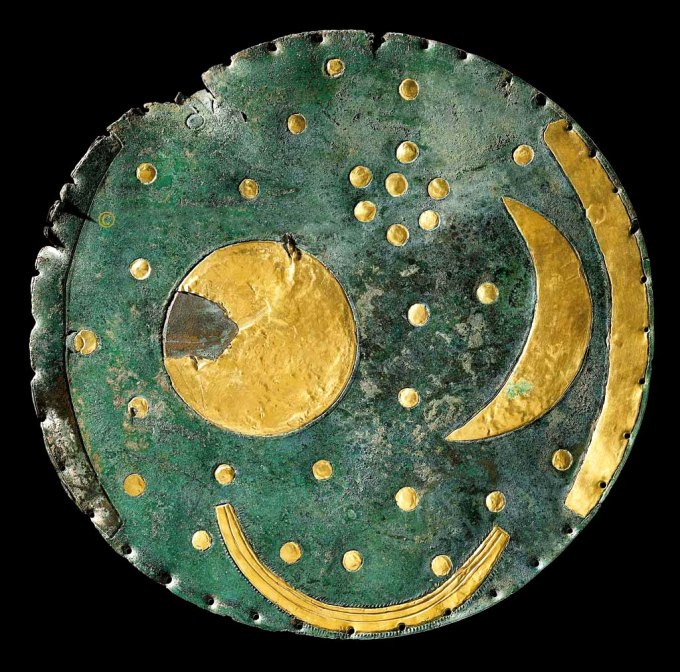The Nebra sky disk was found in Germany, near Nebra, and ever since, European scholars have used it to advance the notion of Euro-centric superiority. It has been dated to the mid-late Bronze Age, at approximately 1600 BC. The claim is that it was made in Germany.
“The Nebra sky disk features the oldest concrete depiction of the cosmos worldwide. In June 2013 it was included in the UNESCO Memory of the World Register and termed “one of the most important archaeological finds of the twentieth century.””
The only problem with this theory is that the disk was probably made in Asia and altered not such a long time ago, in Wales. (This is only my surmise, for the moment; you will see why, below.)
From Wikipedia (emphasis mine):
-
At some later date, two arcs (constructed from gold of a different origin, as shown by its chemical impurities) were added at opposite edges of the disk. To make space for these arcs, one small circle was moved from the left side toward the center of the disk and two of the circles on the right were covered over, so that thirty remain visible. The two arcs span an angle of 82°, correctly indicating the angle between the positions of sunset at summer and winter solstice at the latitude of the Mittelberg (51°N).
-
The final addition was another arc at the bottom, the “sun boat“, again made of gold from a different origin.
The only ‘proof’ of the disk’s European provenance are the gold bands of eighty-two degrees which were added at a later date. How much later is uncertain. I think it was much much later, probably just after it was discovered. In fact, two of the ‘stars’ were even moved to accommodate the gold bands, so how can it be claimed that the knowledge conveyed by them dates to 1600 BC? We have fraud on three levels: provenance; age; forgery.
*UPDATE*
However, an analysis conducted more recently discovered that the gold used was from the United Kingdom – from the river Carnon in Cornwall.
Too bad you can’t date gold.
Jesus’ uncle dealt in tin and traded with the those who inhabited what is now England.
The tin content of the bronze in the disk was also from Cornwall.
How co-incidentally convenient. That’s why they would have it embellished in Wales, just outside (but not really) English jurisdiction.
[Keep your eye on photo4.]
In this video (6:03) [part three of a series of three short films] professor Green displays a mosaic of photos of the disk on her restoration laboratory wall. In these photos, the curved gold object at the bottom of the disk (said to be a solar barge or boat) is both there, and isn’t.
This is the mosaic she assembled with photographs she claims she had nothing to do with creating. Notice how photo 5 is offset to the right.

I superimposed photo 5 onto photo 4 at 50% opacity which is what can be seen in the yellow circle below – “The boat should be here.”

When confronted with these images, professor Green had this to say, “But half the boat is visible on the bottom left picture, exactly where it should be. i may be missing your point but I don’t see the problem.” [sic]
There was clearly nothing in the bottom-left photo. Of course, this is up to one’s interpretation of the meaning of the word ‘left.’ Whereas I meant left as it is viewed – ‘house left’, she may have meant left as in ‘stage left.’ It seems to me that when one is attaching pictures to the wall, the one on the left is self-evident. In all fairness, and given the number of lectures she has probably given, it is entirely possible that this is the whence from which the confusion sprang:
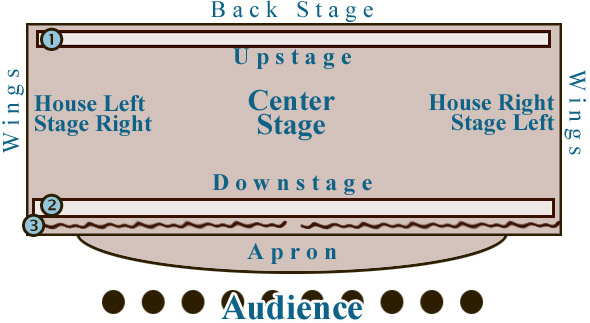
Now, to her credit, professor Miranda Aldhouse-Green is a very reputable scientist, archaeologist, and religious historian. She is professor emeritus and has written a great number of books. She is perhaps best known for her work on the peat bog mummies. I, in no way intended to offend her, defame her, or accuse her of any untoward behaviour. Her reputation is unassailable, after all. I simply wanted to know why her fingerprints were on photos of an obviously trafficked historical artefact posted on the wall of her own restoration laboratory, why she did not notice the obvious anomaly (none of the thousands who viewed these videos on YouTube ever noticed it before I did either, I might add,) and if she had any part to play in the trafficking of said object. Unfortunately, after a brief email exchange with me, she thought my questions too aggressive, was resentful of my implications, and did not, “wish to get into this.” She claims not to remember much about it at all, it having happened so long ago, that she had no part in the imaging of the disk, and that she was merely there to offer commentary about the meaning of the disk.
This is odd considering the disk is considered to be one of the most significant discoveries of the 20th century, but if you’ve seen one, I suppose you’ve seen them all, or so the saying goes. She has asked me not to contact her again. Given her status and her reputation, I will, of course, honour that request. I meant no offense and was simply seeking answers to my numerous and decidedly direct questions. On the other hand, it seems to me that when one is presented with five images of a thing and a large enough table, the first thing one does is to put them together like the pieces of a jigsaw puzzle, in which case the anomaly would have been obvious to anyone, let alone an expert such as herself, as it had been to me after having only seen the video images for a few seconds. Nevertheless, I suppose this one slipped by the expert.
[I am in no way ‘out to get’ Dr. Green, which is why I gave her a chance to respond – which she seriously blew. I will continue to give her the benefit of the doubt; that is, until she admits her complicity or her incompetence in this whole sordid affair.]
Perhaps she had a restricted time budget. Those documentary film shooting schedules can be very tight, no seriously, and she is probably a very busy woman. It is more than just plausible (deniability.) [Please forgive me the sarcasm. It is one of the few joys of writing.] In all seriousness however, if she had been given just five minutes to shoot the clip, and she had already done her research about the disk ahead of time, she may not have noticed the anomalies. Fair enough. Then again, she did offset photo 5 by a considerable amount in order to isolate the boat for the sake of commentary (she did it quite deliberately,) and had she not done so, this article would have been far less interesting, admittedly. But having said that, why put up photo4 first, as it contained no information besides the information contained in its lack thereof? Are you still following this? Mysteries abound. Onward.
If there is any doubt as to the photographic evidence presented above, this is a découpé of the images on the video, taken at different times.
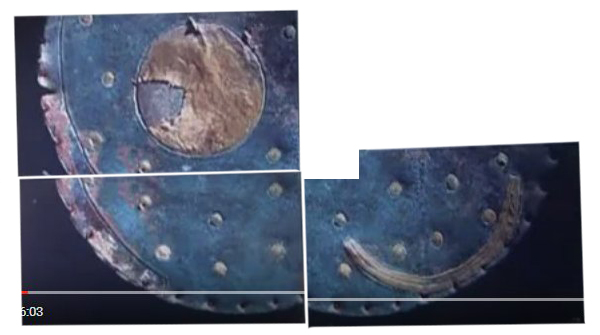
… I ask you, where is the boat? Even the sun is missing from photo 4. (photo 4 is the one on the bottom left, house left, to be precise.)
The only conclusion one can come to is that the photos show the disk in different stages of manufacture. In case you are wondering about photo-manipulation, the patina under the spots where both the boat and sun should be does not show any repeating pattern similar to anywhere else on the disk, as far as I can tell.
This is not to say that Heinrich Wunderlich, the man who authenticated the corrosion on the bronze parts of the disk (see video #1) was incorrect. The disk could very well be authentic and his estimate of the age of the bronze could very well be accurate. As far as I know, he only analyzed the bronze portion of the disk since oxidation does not occur on gold. Remember that the gold leaf depicting the three arcs was definitively added afterwards, and perhaps more. Perhaps, indeed, all of it was.
What about the holes punched around the outside of the disk? What is their purpose? This disk, it would seem to me, was probably an adornment originally made as a breastplate. Adding some of the gold leaf in order to further the story of Euro-centric knowledge of the stars would not have been difficult, especially for someone with a lab full of specialized restoration equipment, as exists in Cardiff. Did I mention that professor Green was from the University of Cardiff in Wales?
The Saracens, Indians, Persians, Ottomans, and even Genghis Khan all wore similar breastplates. These designs were not typical of European armour. This would explain the holes punched around the circumference of the disk which could serve as attachment points to the rest of the armour. [n.b. Note the top-left image below. On that particular breastplate, there seems to be a band along the bottom which is very similar to the bands on either side of the Nebra disk. It could have been made with leather, as is shown in this example, or with a separate piece of metal. It may have served as either a re-enforcement or in order to limit wear on the ‘stitches.’ Maybe it was simply decorative. In any case, it looks pretty darn close to 82°. This particular armour suit is, ironically, housed in the Kunsthistorisches Museum in Wien, Austria. [Not Germany, but close enough.] How have all the experts missed this simple fact? It is simply supposition on my part; nevertheless, it should be retained as a possibility.
The Nebra disk is not as ornate as these examples, but perhaps it was not destined to adorn a general, either.
The crescent was well used in the iconography of the Ancient Near East and was used transplanted by the Phoenicians in the 8th century BC as far as Carthage in modern Tunisia. The crescent and star also appears on pre-Islamic coins of South Arabia.
The combination of star and crescent also arises in the Ancient Near East, representing the Moon and Ishtar (the planet Venus), often combined into a triad with the solar disk. It was inherited both in Sassanian and Hellenistic iconography.
(Keep in mind that the sun symbol on the disk seems to have been added later. It may originally just have been a star and crescent design, if anything at all.) Triads can be depicted with five, six, or eight-pointed stars, and sometimes even more.

An obvious triad combining the sun, the moon, and one star – not seven stars. See below. Why this is assumed to be the Pleiades is beyond me. In 1600 BC, with no light pollution or smog, I would think that more than seven of the stars in that constellation would have been visible. Galileo noted a total of thirty-six. The cluster actually contains over one thousand stars, fourteen of which can be seen with the naked eye. Interestingly, the cultures of Japan and India (amongst others) associate the Pleiades with the number six.
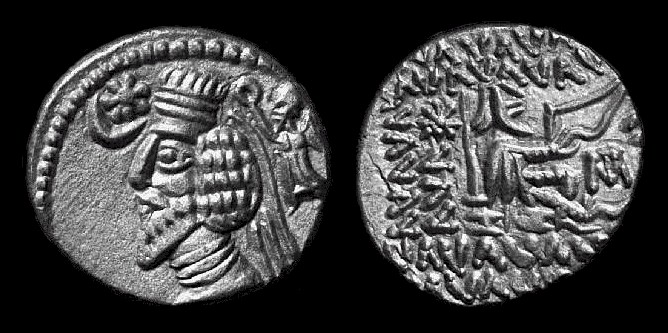
Above is a Parthian (Iranian) coin from the first century BC Note the moon and star motif. (The star depicted on the coin above appears to be six-pointed with a bar connecting the star to the moon, as is often the case. It looks a lot like our Pleiadean group, does it not?)
Could the disk have originally belonged to an Asian invader? Did the Huns bring it to Europe as some sort of inspirational and motivational artefact in their attempt to overrun ancient Germany? Did it arrive much earlier as an object for barter or an adornment for clothing? If some of the elements on the disk are authentic, are they of Asian origin or design? The 51st parallel runs right through Inner Mongolia, after all. The Asian astronomical tradition is ancient and well-reputed, and trade routes from the Indus Valley, Mongolia, and all over the near-east to the Mediterranean are well-established, once camels had been domesticated in the early to mid Bronze Age.

“On 20 June 2007 a multimedia visitor center was opened near the discovery site at Nebra.” This center obviously cost a great deal of money to build, and tourists pay a fee to visit.
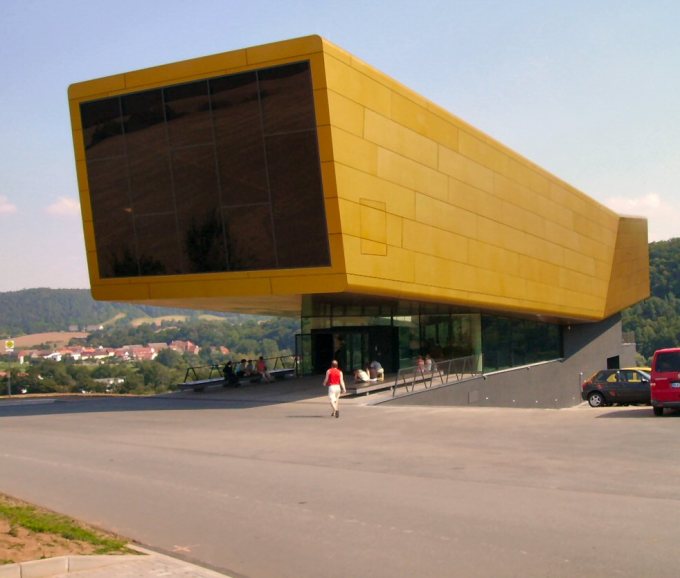
However, the disk is part of the permanent exhibition in the Landesmuseum für Vorgeschichte (State Museum of Prehistory) in Halle. The museum states that the disk is an object from the early Bronze Age. Even in the technologically late-blooming Europe, 1600 BC must be considered mid-late Bronze age. The Bronze Age started much sooner in the east, after all.
If there has been a forgery of the disk, it has cost the people of Germany, the tourists to Germany, and the people of Asia, where it belongs, quite a lot of money. The people have a right to know whether this object is authentic or not, and an investigation into this matter should begin immediately. There must have been many people involved in this scheme.
So, an Asian artefact, found in Europe seems to have been dressed up to look like it was local, and the myth of European supremacy lives on. The people of Europe, and the rest of the world for that matter, may have been duped. Asian knowledge has, as it would seem, once again been appropriated by the west for nothing more than bragging rights.
